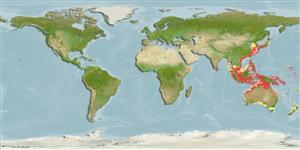Environment: milieu / climate zone / depth range / distribution range
Ecologie
marien rifbewoner; diepte ? - 100 m (Ref. 90102). Tropical
Indo-West Pacific: India east to Indochina, then north to Japan and China to the Philippines, Indonesia and Australia.
Grootte / Gewicht / Leeftijd
Maturity: Lm ? range ? - ? cm
Max length : 29.5 cm TL mannelijk / geslacht onbekend; (Ref. 126280); max. gepubliceerd gewicht: 453.00 g (Ref. 126280)
Dorsale stekels (totaal): 4 - 5; Dorsale zachte stralen (totaal): 13-14; Anale stekels 13. Indonesian form has pale body with dark blotches (Ref. 48636). Body dark brown with 3 distinct broad black bands. Respiratory valve inside lower jaw with a thick orange tentacle (Ref 42788).
Found above 100 m on sandy gravel bottom (Ref. 11230). Lives on muddy substrates and rarely observed (Ref. 48636). Hides in sandy bottoms and sucks up animals with sand and debris into the mouth.
Levenscyclus en paargedrag
Maturiteit | Voortplanting | Paaien | Eieren | Fecunditeit | Larven
Masuda, H., K. Amaoka, C. Araga, T. Uyeno and T. Yoshino, 1984. The fishes of the Japanese Archipelago. Vol. 1. Tokai University Press, Tokyo, Japan. 437 p. (text). (Ref. 559)
Status op de Rode Lijst van het IUCN (Ref. 130435)
Gevaar voor de mens
Harmless
Gebruik door de mens
Visserij: van minder commercieel belang; Aquarium: Commercieel
Meer informatie
Lokale namenSynoniemenMetabolismePredatorenEcotoxicologieVoortplantingMaturiteitPaaienPaaiaggregatiesFecunditeitEierenOntwikkeling van de eieren
ReferentiesAquacultuurAquacultuurprofielKweeklijnenGeneticaElectrophoresesErfelijkheidZiektesVerwerkingNutrientsMassaconversie
Tools
Speciale rapporten
Download XML
Internetbronnen
Estimates based on models
Preferred temperature (Ref.
123201): 22.9 - 29, mean 28 °C (based on 1308 cells).
Fylogenetische diversiteitsindex (Ref.
82804): PD
50 = 0.5000 [Uniqueness, from 0.5 = low to 2.0 = high].
Bayesian length-weight: a=0.01072 (0.00554 - 0.02071), b=3.09 (2.92 - 3.26), in cm total length, based on LWR estimates for this species & Genus-body shape (Ref.
93245).
Trofisch niveau (Ref.
69278): 4.1 ±0.7 se; based on size and trophs of closest relatives
Weerstandsvermogen (Ref.
120179): Gemiddeld, minimale populatieverdubbelingstijd 1,4-4,4 jaar (Preliminary K or Fecundity.).
Fishing Vulnerability (Ref.
59153): Low vulnerability (20 of 100).
